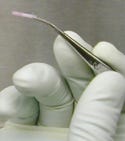Student Teams Awarded for Breakthrough Medical Devices
Originally Published MDDI July 2006INDUSTRY NEWS Erin Bradford
July 1, 2006
INDUSTRY NEWS
|
The NanoGraft device constructs vascular grafts from bone marrow stem cells. |
Newcomers to the device industry are often commended for their ability to look at problems from new angles or bring a fresh perspective to the table. That's the idea behind the Biomedical Engineering Innovation, Design, and Entrepreneurial Award (BMEidea). This year's winning teams did just that—their inventions each represent a breakthrough in medical device innovation.
“[These teams'] innovations show promise to change the future of healthcare, and we are thrilled to support them as they move forward,” says Phil Weilerstein, executive director of the National Collegiate Inventory and Innovators Alliance (NCIIA; Hadley, MA). Weilerstein and Jay Goldberg, director of the Healthcare Technologies Management Program at Marquette University (Milwaukee), created the competition.
An initiative of NCIIA, the competition was established to encourage student biomedical innovators to move their ideas from the lab to the market. To be considered for an award, project entries must focus on an original health-related technology. Students must invent the device, and the device must address a real clinical need. Entries are evaluated on technical, economic, and regulatory feasibility as well as their contribution to human health and quality of life. Social effect, technological innovation, and potential for commercialization are also taken into account.
|
The Ultramed team improved ultrasound technology to better detect breast cancer. |
This year, first prize went to NanoGraft Technologies from the University of California, Berkeley. The team created a tissue-engineering approach to construct vascular grafts from bone marrow stem cells. These smart grafts, or nanografts, can be used in coronary artery bypass graft procedures. The grafts are custom and adaptable, giving them a higher likelihood of success than traditional grafts. NanoGraft Technologies received a $10,000 cash prize.
The Ultramed Ultrasound Breast Cancer Detection team and the AnemiCAM system tied for second place; each team received a $2500 cash prize. The Ultramed team developed alternatives to available breast cancer detection methods by improving current ultrasound technology. The detection system offers advantages over mammography, which may fail to detect cancer in women with high breast density.
|
The AnemiCAM lets doctors assess hemoglobin levels quickly and noninvasively. |
The AnemiCAM was developed by a team from Brown University. The team created a light-reflecting device that enables physicians to quickly and noninvasively assess hemoglobin levels by shining the light in the lower eyelid. As a result, physicians can better detect anemia. In addition to its innovation, the device can be manufactured for less than $30, opening the door for it to be used in third-world countries.
|
The Robopsy facilitates earlier, more-accurate diagnoses of cancerous lesions. |
The Robopsy, developed by a team from the Massachusetts Institute of Technology, received the third-place prize. The team developed a telerobotic biopsy system that facilitates earlier, more-accurate diagnoses of cancerous lesions. In fact, initial trials indicate the method can detect lesions as small as 5 mm; current procedures are reliable only to 20 mm.
The winners were announced on June 6, 2006, at the MD&M East Exposition and Conference in New York City. The BMEidea competition is sponsored by NCIIA. Additional sponsors include MD&DI, the Industrial Design Society of America, the National Science Foundation, and Guidant Corp. It is endorsed by the Biomedical Engineering Society and the Council of Chairs of Bioengineering and Biomedical Engineering Programs. More information about the BMEidea competition can be found on NCIIA's Web site, at www.nciia.org.
Copyright ©2006 Medical Device & Diagnostic Industry
About the Author(s)
You May Also Like





